Hitting the Streets of New Capenna, Part 2
Welcome to the second week of Streets of New Capenna previews. Last week, I started telling the story of the set's design and showed off some preview cards. Today, I'm going to introduce you to the Vision and Set Design teams, continue telling the story of the set's design, and show off a cool new preview card, a legendary creature no less.
Partners in Crime
As is always the case, I like to have the team lead introduce their team members. Normally, I have the Vision and Set Design teams introduced individually, but for this set, everyone on the Vision Design team, save one person (me), was also on the Set Design team, so I'm just going to have Jules Robins introduce the Set Design team and I'll note who was also on the Vision Design team. You won't get a bio for me, but because I'm on every Vision Design team, I've gotten more than my fair share of bios over the years.
Click here to meet the Set Design team
Jules Robins (late set design lead)
In my seven years at Wizards, I've worked on Magic sets across the whole of the design process, from exploratory design all the way through the Future Future League. In the past, that's resulted in me leading set design on projects like Commander Legends and Dungeons & Dragons: Adventures in the Forgotten Realms with tons of big-picture questions in need of answers. Streets of New Capenna was something new for me: polishing a set where someone else had begun set design and already solved the final structure.
Mark Gottlieb (vision design lead/early set design lead)
Mark Gottlieb not only pitched the concept for this set at the outset and led both exploratory design and vision design, but he also led the first section of set design. He brings a great sensibility for finding fun mechanics and themes with delightful interplay, but moreover, he's the studio's foremost expert on capturing charming top-down card concepts in rules text. He brought all those skills to bear on this set, and by the time I joined the Set Design team, the set was already full of most of the final mechanics and a plethora of card concepts capturing all the charming tropes and feel of a mobster movie. If you enjoy Streets of New Capenna, now you know whom to thank.
Andrew Brown (set design/competitive play design lead)
Andrew and I used to play competitive Magic together in Los Angeles; now we're both at Wizards, and he heads up competitive play design! Andrew brings that expertise to positioning cards and decks to succeed in Standard and keep competitive drafts engaging, but he also brings a keen sense of what appeals most to newer and less competitive players and combines the two to ensure every set he touches is filled with goodies for everyone.
Carmen Handy (set designer)
This was Carmen's first Set Design team after joining competitive play design, and she hit the ground running, leveraging her wide competitive background to contribute a ton of great insights about format pressures and applications for cards in a range of contexts—plus, some sweet card designs to boot! She hasn't slowed down either, so expect more great things to come.
Noah Millrod (vision/set designer)
Coming over from the sales side, Noah was a perfect pick to join this set oozing with resonant flavor. He has a knack for capturing the core of a concept in card form and finding the tiny bits of text to make flavor sing, and he exercised both here.
Ken Nagle (set designer)
Ken's done a lot of design since making the finals of the first Great Designer Search back in 2006, and somehow, he still comes at every problem from a different angle than the rest of the design group. Ken's a master of solving stumbling blocks that aren't on anyone else's radar. I never know whether the next connection he makes will be about tuning into a trend in movie production or avoiding a physical dexterity hurdle, but I know to pay attention.
Ari Nieh (vision/set designer)
Ari came to Wizards by winning the Great Designer Search 3, and the shoe fits. She's especially good at finding two polar opposites that every set needs: mechanical space that's fun to play a lot with and tweak across a bunch of card designs, and one-off cards that turn the game on its head in interesting ways.
Michelle Roberson (set designer)
Michelle came to the studio midway through Streets of New Capenna set design and immediately hopped on the team. Even while learning the ropes, she lent an eye for flavorful concepts and different angles to fill mechanical needs as we redesigned cards that weren't working. Now she's joined the Casual Play Design team, so you'll soon be seeing her hands on every set!
Donald Smith Jr. (vision/set designer)
Donald was the set's competitive play design representative during vision design and the first part of set design. In addition to lots of balance passes and looking ahead to potential competitive impacts, he played a big role in shaping the mechanical identities for the families to mesh well with the Standard environment they'll enter as well as filling gaps in their limited strategies.
Reggie Valk (set designer)
Reggie plays a huge amount of Magic across a ton of formats and always brings that experience to bear in identifying opportunities to make cards cooler for a wider range of players. In this set, he offered even more: lending his acumen for finding cute, flavorful space to make sure the set not only hit core Golden Age and mobster tropes but also more lighthearted ones that still felt at home.
Cameron Williams (set designer)
Cameron kicked off his summer internship with a bang, churning out cool card designs at a rapid clip and finding all sorts of tweaks to mechanical space that opened up room for more cool cards. For instance, you have Cameron to thank for the final form of connive as a keyword action that cards can use to reward different things.
Family Feud
Last week, I ended our story with Mark Gottlieb being assigned as the lead designer for the Vision Design team (and the beginning of set design, as Mark shines best at the middle part of design) and agreeing to use the Khans of Tarkir structure as the starting point for the set. The major task we had to tackle was giving each of the five factions, which we called families, a mechanical identity including their own keyword mechanic.
In addition, because we were making a multicolor faction set, we had to care about how the factions interacted with each other. Because each faction has three colors, that meant it overlapped with two colors, with two factions, and with one color with the other two factions. As a result, every color would feature three different factions and any one faction would have mechanics from all five families showing up in its three colors.
As it was an arc set (i.e., a color and its two allies), that meant the secondary themes would be the ally color pairs, which we also had to think about as we were building our factions, specifically in how the keyword mechanics overlapped mechanically. This means that, while we were working hard to make each faction play as well as it could in a vacuum, we also had to think about how each one interacted with the other factions in the set. It means the design required a robust and complex structure.
Another complication had to do with it being a three-color set. The color wheel is set up to handle monocolor and two-color themes easily. Each color has its own identity, and we've worked hard to make sure there's mechanical overlap between each of the ten two-color pairs. When you get to three colors, though, you often get the problem that any one effect is usually not core to all three different colors. It works out occasionally, but usually at least one of the colors is a bit of a bend. Our strategy was to make sure any mechanic was core to the center color of the faction, was available in one of the other colors, and wasn't a break in the third color.
My main point before I start talking about how we designed each faction is that there are a lot of moving parts and larger set concerns that make the decisions about how to handle any one faction mechanically a lot harder than it might seem at first blush. That said, let me walk through families one by one:
The Brokers (green-white-blue)
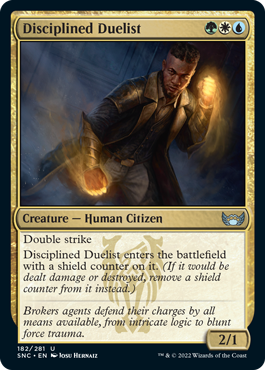
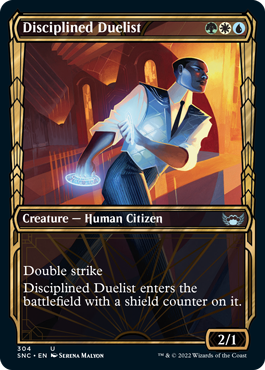
This is the white-centered family that commits crime using structure and order. They are a law firm that controls large areas of the city with their ability to warp the law to their favor. We decided that with this family we wanted to focus more on defense than offense. Part of using order as weapon is making it harder for your enemies to be able to harm you.
Magic has dabbled a lot in this space over the years. Alpha had protection, regeneration, and damage prevention. We've made ways to keep you from targeting creatures (shroud, hexproof, etc.); made it harder to target creatures (ward); discouraged you from targeting creatures, at least the opponent's creatures (death triggers, heroic, enrage, etc.); shrunk the creature instead of it dying (Phantom mechanic); and made it so creatures that died could come back (Phoenixes, persist, undying, etc.).
For the Brokers, we took a combination of these ideas to make something new—shield counters. The idea behind a shield counter is that it proactively protects a creature. If the creature is ever damaged or destroyed, in place of that damage or destruction, the creature loses its shield counter. The flavor being that the Brokers could use their power to see to it that certain creatures were protected.
Interestingly, shield counters were the first of the printed mechanics to be added to the file. Mark Gottlieb had tried putting them in previous sets (I believe they were in the Dungeon & Dragons: Adventures in the Forgotten Realms design for a while) and was looking for a place to use the mechanic. On the first day of vision design, Mark made some suggestions for the family mechanics, and shield counters was his suggestion for the Brokers. We liked the concept of shield counters but were concerned with their execution. We wanted creatures to be harder to kill, but not too much harder. We were a little worried about how easy it would be to tell shield counters apart from +1/+1 counters, and we were concerned that they might feel less powerful than they were. Luckily, as we playtested, we found these issues were all manageable and the mechanic was fun.
The Obscura (white-blue-black)
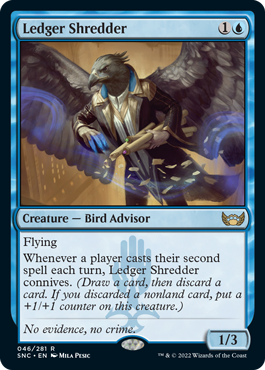

This is the blue-centered family that commits crime through the use of information and manipulation. They are wizards that use their magic to deceive and scheme. For this family, we were interested in finding a way to turn knowledge into power (and we ended up doing that literally).
The first shot at the family mechanic was called mindhack. It went on creatures, and it allowed you to have the creature enter tapped and get a looting effect (draw a card and discard a card). The problem was the looting was so valuable that 95 percent of the time people were having the creatures enter tapped. A modal mechanic isn't interesting if you only ever do one mode, so we looked for ways to tweak it.
This led us to look for other ways to create a mechanic that incorporated looting. Inspired by explore (Reveal the top card of your library. Put that card into your hand if it's a land. Otherwise, put a +1/+1 counter on this creature, then put the card back or put it into your graveyard.), we tried connive. By replacing the ability to look at the top card of your library with a looting effect, we gave the player more agency to try and get the +1/+1 counter if they needed it. We felt this did a good job of adding a component of cleverness and manipulation that helped capture the feel of the family. We made the discarding of a nonland the means to get the +1/+1 counter because that meant you were getting rid of a spell you could be casting, as opposed to a land that is often meaningless late game.
As it turns out, my preview card for today is from the Obscura (as are all the previews today).
Click here to meet Toluz, Clever Conductor
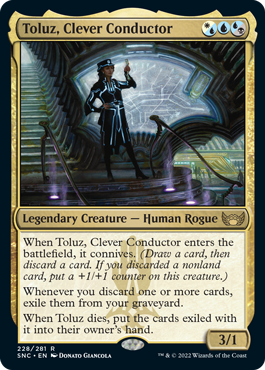

Toluz was designed as a commander that encourages you to build a deck around discarding. That can be with connive or with any other blue or black ability that requires discarding cards.
The Maestros (blue-black-red)
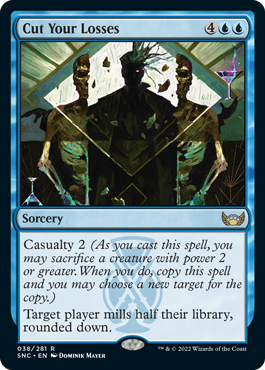
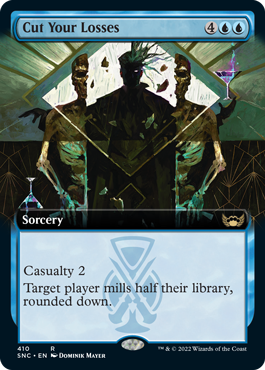
This is the black-centered family that commits crime using ruthlessness and murder. They are assassins that are willing to kill to remove any obstacles that stand in their way, or to make a tidy profit. For this family, we wanted to capture the willingness to do whatever it takes.
Early on, we considered bringing back morbid (if a creature died this turn
This led us to a mechanic called splatter. We liked the idea of a mechanic that allowed you to sacrifice a creature to adapt the spell in some way. We talked through a few different variations (such as making the spell stronger or forcing the opponent to sacrifice a creature), but ultimately liked the idea that the rider let you copy the spell. In play design, casualty, as the mechanic is now called, got a number added to it. This number restricts what creatures you're allowed to sacrifice to copy the spell (you can only sacrifice a creature with a power equal to our higher than the listed number). The need for the number came about as it was hard costing spells when the payment remained the same even when the spells got more expensive. Play design either needed a new knob to adjust or the mechanic would have to be restricted to spells in a similar mana value band. The former let us make more cool cards.
The Riveteers (black-red-green)
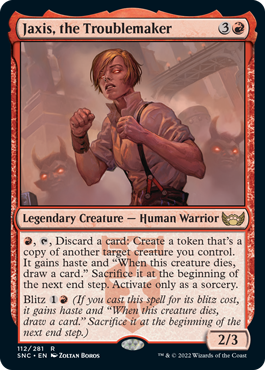
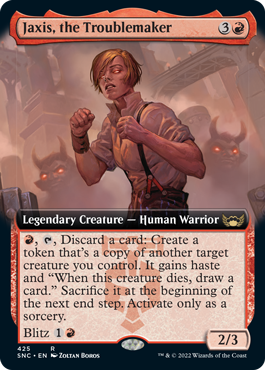
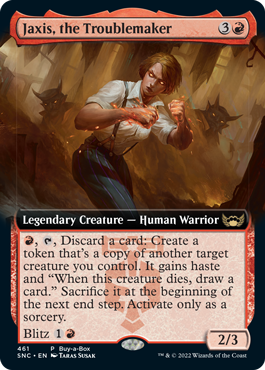
This is the red-centered family that commits crime through intimidation and brute force. They are the artisans of the city who will use their fists to get whatever it is they feel they deserve. For this family, we wanted a mechanic that played into their impulsive spirit.
The first mechanic we looked at was called rumble, and it was a rider on spells that allowed you to pay 2 life to get a 1/1 creature token. (It was inspired by a mechanic we had in early Ixalan design where you could pay mana as a rider to get a 1/1 creature token.) The thought at the time was that this family was of the people and the streets, and so it having its numbers constantly growing would be flavorful.
It ended up having several problems, though. One, the Cabaretti were more about having numbers mechanically, so this was pushing off-message a little. Two, the mechanic worked very well with both adjoining families (for example, it gave you a creature to sacrifice for casualty and a body for alliance), but it wasn't creating an identity for the Riveteers.
We then talked about a bunch of different ideas but ended up bringing back the dash mechanic (You may cast this spell for its dash cost. If you do, it gains haste, and it's returned from the battlefield to its owner's hand at the beginning of the next end step.) from Fate Reforged and Dragons of Tarkir. We really liked the impulsive nature, but it wasn't playing as nicely with its neighbors as rumble had.
This inspired us to come up with a variant of dash, which we called bash in design. The idea for bash was that instead of going back to your hand, it got sacrificed at end of turn and drew you a card. Combined with "enters the battlefield" and death triggers, it allowed us to make a lot of neat designs that gave the player interesting choices.
The Cabaretti (red-green-white)
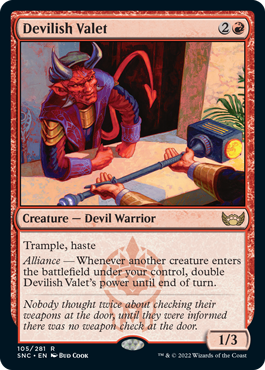
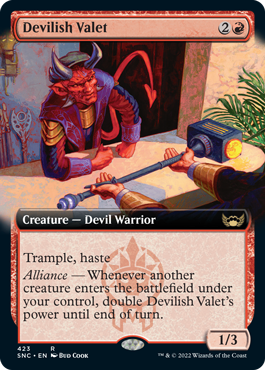
This is the green-centered family that commits crime through the power of community and tradition. They are a cult of druids that runs the main entertainment of the world. For this family, we wanted to play into the power of the group and enable a go-wide strategy.
We started with a mechanic called cartel that was a creature version of metalcraft (spells that got an upgrade if you controlled three or more creatures). However, the mechanic was always a bit lackluster and no one really gravitated to it, so we started looking for another option.
I pushed hard for a mechanic that I'd been trying to get into sets for years, what we casually called creaturefall. Just like landfall, it was a trigger that cared about when creatures entered the battlefield. Watching the success of landfall and constellation, creaturefall seemed like a slam-dunk mechanic. People like playing creatures. Let's reward them for doing that.
Creaturefall had been the mechanic I handed off for the Selesnya (green-white) guild in Guilds of Ravnica, but it got changed during set design. There was some concern from the team that the mechanic was boring, as it was just an obvious extension of other mechanics. I argued that it would play well and that its association with other popular mechanics would make players like it more, not less.
Because the design had been going well, Mark Gottlieb suggested a variant on it where only the second creature that entered each battlefield each turn would trigger the effect. This would make for different play patterns and allow for bigger effects.
Playtesting showed the new version had some issues. One, it just didn't happen often enough. Two, it got frustrating in the late game when you ran out of cards and it became very hard to trigger. Three, it just wasn't as much fun as the normal creaturefall. The mechanic was changed back, getting the name alliance.
Family Gatherings
Another ongoing issue as we put together our families was making sure that there were themes between the families. The place this was most important was in the ally color combinations. When making a set, we tend to have five primary drafting archetypes and five secondary drafting archetypes. For Streets of New Capenna, the former includes the three-color factions. The latter includes the ally color combinations, as each ally combination can be found in two families. This allows a drafter to start drafting ally colors while having the freedom to stay in those two colors or add one of two different colors to play a family.
Here are how we crafted each of the two-color combinations:
White-blue
The Brokers use shield counters and the Obscura use the connive mechanic, which generates +1/+1 counters, so this archetype cares about creatures with counters on them.
Blue-black
The Obscura use the connive mechanic, which involves looting (drawing and discarding), and the Maestros use the casualty mechanic, which involves creature sacrifice, so this archetype has a theme of caring about whether five different mana values are on cards in your graveyard. This is a bit slower of a theme as it takes time to build up to the threshold condition.
Black-red
The Maestros use casualty, which involves sacrifice, and the Riveteers use blitz, which also involves sacrifice, so this archetype has cards that care about creature sacrifice.
Red-green (with elements of five-color)
This archetype proved to be a bit more difficult. As is often the case, it's hard to create a system where every pair of adjoining factions overlap cleanly with their mechanics. The Riveteers use blitz and the Cabaretti use alliance, so there is a little bit of creature interaction, but the Set Design team decided to make this archetype about treasure. Red and green are the two colors most associated with creating other colors of mana, so both could support a bunch of treasure making. There are also several cards that care about treasure or treasure usage in various ways. By using treasure, this archetype is the one that lets you splash other colors the easiest. The treasure flavor also played nicely into the feel of opulence that was core to this family.
Green-white
The Cabaretti want you to have a lot of creatures, and the Brokers protect creatures with shield counters, so the Set Design team decided to make this the tribal archetype, caring about Citizen creature tokens. Green and white have the highest creature counts, so it works well with a tribal theme.
Family Gatherings
And that is how Streets of New Capenna was put together. I hope you all enjoyed the story, and I'm eager to hear any feedback about this column, any of the mechanics I talked about, or the set itself. You can email me or contact me through any of my social media accounts (Twitter, Tumblr, Instagram, and TikTok).
Join me next week when I tell some card-by-card stories from the set.
Until then, may you find the family that best suits you.
#921: Non-tournament Design
#921: Non-tournament Design
32:10
When Unglued was first concepted, the idea behind it was that we could design cards for non-tournament play. What exactly does that mean, and what does it entail? In this podcast, I explore the parameters of non-tournament design.
#922: Lesson Learned – Ikoria
#922: Lesson Learned – Ikoria
31:58
This podcast is another in my "Lessons Learned" series where I explore what I learned during the making of sets for which I led or co-led design.
- Episode 920 Managing the Rules with Jess Dunks
- Episode 919 Oath of the Gatewatch with Ethan Fleischer
- Episode 918 Stories from Japan

